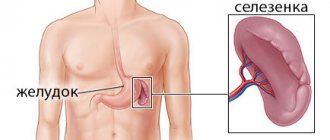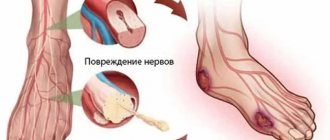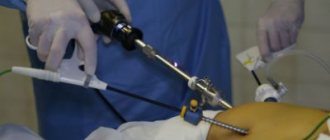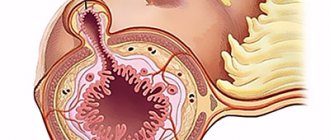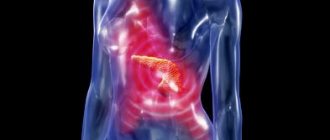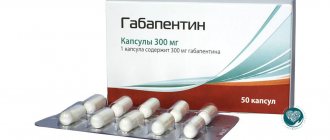The unexpected happened... Car sirens, flashing lights, people in white coats and the light of lamps in the operating room. I came to my senses and heard the diagnosis - your spleen was removed. Another case is planned. But it’s also a sad diagnosis; the doctor recommends a splenectomy. A whole list with tests, hospitalization, lamps, anesthesia, intensive care. The bottom line is the same: the spleen has been removed, what are the consequences of this?
What kind of organ is this? What functions does it perform in the body? How to live further and what are the consequences, prognosis of the operation? The patient asks himself and the attending physician these questions. Let's try to understand this issue.
What is this organ responsible for in the human body?
The spleen is located in the left hypochondrium between the 9th and 11th pairs of ribs.
The spleen has long been considered a secondary human organ. There was even an opinion that other organs should be protected, but this one is not a pity. This continued until its functions and structure were studied.
The spleen is full of blood vessels. Blood entering this organ receives a fresh portion of developing leukocytes - cells responsible for the body's immune defense.
In the spleen, the disposal of obsolete blood cells, viruses, and foreign particles that have entered the circulatory system occurs. In addition, the organ is responsible for hematopoiesis and blood coagulation processes.
This organ is located in the left hypochondrium between the 9th and 11th pairs of ribs. The appearance of the spleen is similar to that of a coffee bean. You can live without it. The person continues to lead an active lifestyle and does not become disabled.
Contraindications
After a standard operation to remove the spleen, a long and clearly visible scar remains on the body
There are few contraindications to traditional or laparoscopic splenectomy. For elective open splenectomy, the only absolute contraindications are uncorrectable coagulopathy and severe cardiovascular disease, which prohibit the administration of general anesthetics.
Although reports have been published on the safety of laparoscopic splenectomy in patients with cirrhosis and portal hypertension, these conditions are considered by many to be an absolute contraindication.
Why remove the spleen? Indications for surgery
The spleen is removed when the blood vessels in the organ itself are damaged.
There are no superfluous or unnecessary organs in the human body. And therefore, the spleen is removed only for vital indications, and not in accordance with the wishes of the patient. Splenectomy surgery is performed in the following cases:
- Injuries to an organ that are incompatible with the further performance of its functions.
- Rupture of the spleen, regardless of the reasons that caused it. This may be trauma, medication, acute intoxication, tumors and infectious diseases such as mononucleosis.
- Damage to blood vessels in the spleen. Internal bleeding.
- HIV infection.
- Myelofibrosis is the replacement of bone marrow tissue with fibrous cords.
- Leukemia, organ tumors of various etiologies.
- Pathological enlargement of the spleen.
Surgical intervention can be emergency - usually due to injury - or planned.
Why is it better to have a splenectomy at the Swiss University Hospital?
- For more than 20 years, our clinic has been providing surgical treatment for diseases of the spleen; we were one of the first to use organ-preserving techniques and perform operations using a gentle method.
- The clinic’s specialists have patented many methods of organ-preserving interventions on the spleen, including resection or removal with autotransplantation of spleen tissue into the greater omentum in order to preserve the immunological properties of the body. Back in the 90s, our specialists—one of the first in the country—performed a unique intervention on a pregnant woman, and the success of the splenectomy was confirmed by the fact that the child was absolutely unharmed and the birth took place naturally.
- We have more than 40 patents for bloodless techniques; in addition, blood loss and trauma to the pancreas during surgery are eliminated thanks to the use of the latest generation equipment: ultrasonic scissors, endoscopic staplers and the LigaSure system.
- At the same time, during surgical intervention in our clinic, you can perform other procedures: biopsy of the liver, lymph nodes, and also get rid of concomitant pathologies of the pelvic or abdominal organs.
Consequences
Pain in the left hypochondrium after surgery should alert the patient.
All consequences are conventionally divided into immediate ones, which can occur immediately after the intervention or during the rehabilitation period, and long-term ones. In both cases, much depends on the patient’s behavior. Immediate consequences of splenectomy:
- Bleeding
- Infection of the wound surface
- Injury to other organs and tissues
- The appearance of blood clots or blood clots
- Hernias at the site of insertion of instruments into the abdominal cavity
- Changes in the blood formula. This complication may persist throughout life.
- Sepsis
- Liver and gastrointestinal dysfunction
All these pathologies are considered immediate and especially dangerous within 2 years after surgery. What should the patient be wary of during this period:
- Severe pain in the operated area
- Any signs of infection - pain, burning, purulent discharge, fever, chills
- Bleeding or any other discharge from the insertion site
- Cough
- Nausea, vomiting, other dyspeptic disorders
- Shortness of breath
The occurrence of any of these symptoms is a reason for an urgent visit to the doctor. The following actions will help reduce the risk of developing immediate complications:
- Laparoscopy is a gentle technique. But you must remember that you have had an organ removed. Therefore, no labor feats immediately after discharge.
- Check with your doctor when you can shower or swim. Taking a hot bath is temporarily postponed as the risk of bleeding increases.
- Don't get too cold. This is a situation where it is better to sweat than to freeze.
- Do not drive for 1.5 months after surgery.
- Do not visit places with large crowds of people. Your immune system is weakened, and any virus can develop into a serious illness.
- Do not take pain relievers that contain aspirin.
- Do not lift weights; athletics are also temporarily prohibited.
- Take the medications prescribed by your doctor.
- At any appointment, tell your doctor that your spleen has been removed.
Doctor's comment
Have you been diagnosed and the only effective treatment is splenectomy? In our clinic, each specific case is discussed by a council of doctors. If conservative therapy is ineffective, we always strive to perform organ-preserving surgery, but if removal of the spleen cannot be avoided, we use the most gentle method of treatment. But in any case, you can count on an individual approach. We can also undergo a comprehensive examination, the results of which determine the tactics and effectiveness of treatment. All types of diagnostics are available to patients! If the examination was carried out in another medical institution, you can get an independent (second) opinion from experienced specialists. If you have concomitant diseases, you can always count on the help of other doctors with narrow specializations: an endocrinologist, urologist, gynecologist, etc. Would you like to receive more detailed information about treatment options specifically for your case? Make an appointment, grab the available examination results, and we will find that effective treatment method, thanks to which you will return to your normal lifestyle in a short time, getting rid of the disease forever!
Head of the surgical service at SwissClinic Konstantin Viktorovich Puchkov
Dietary recommendations
Fatty and spicy foods should be removed from the diet after the spleen is removed.
Nature is smart. And if for some reason a person loses an organ, then other organs begin to perform part of its functions, thereby compensating for the deficiency. In the case of splenectomy, the lymphatic system and liver begin to be responsible for the body's immune defense.
Therefore, it is important to adhere to a gentle diet. During the rehabilitation period, it is aimed at reducing the load on the liver, injured peritoneum and other gastrointestinal organs. In the future, it is recommended to adhere to the principles of a healthy diet. The following should be removed from the diet:
- Heavy and fatty foods
- Spicy seasonings and marinade
- Fat meat
- Dishes cooked in a large amount of fat, deep-fried
- Fatty, rich bone broths and dishes based on them
- Strong coffee and alcoholic drinks
- Cigarettes and drugs
What can you eat after spleen removal:
- Doctors recommend introducing a large amount of vegetables into your diet, both raw and cooked.
- Fruits in any quantity - fresh and prepared
- Liquid at the rate of 30 g per 1 kg of patient weight
- Cereal dishes
- Dairy and fermented milk products with a small percentage of fat content
- Fish, meat - choose low-fat varieties or cuts. For the first time after surgery, cook by steaming or in the oven.
- Medicinal herbs that improve the flow of bile and liver function should be taken periodically in courses as recommended by a doctor.
How to eat properly after gastric resection
Now, having understood the burden placed on the digestive organs, you can move on to the rules of a healthy lifestyle and, most importantly, nutrition.
- The first stage of digestion begins in the oral cavity, where food is mechanically processed and soaked in saliva. Thanks to saliva enzymes, the digestion of food in the gastrointestinal tract is facilitated. Under the action of salivary enzymes, simple sugars are absorbed in the oral cavity. You need to chew slowly, without rushing; if your teeth are good, you can chew a piece of meat.
- You need to eat often, 5-6 times a day, observing the rhythm of food entering the digestive tract.
- It is necessary to monitor the amount of food taken at one time; the volume should be no more than 1 glass (200 ml).
Possible complications
After splenectomy, the risk of developing bacterial and fungal infections increases throughout your life. First of all, patients suffer from pneumococci, meningococci and Haemophilus influenzae. Some patients develop sepsis and other life-threatening complications within hours of having their spleen removed. Any fever may be a sign of an infectious disease. In this case, intravenous or intramuscular administration of antibiotics is recommended. After splenectomy, the patient is given an antibiotic tablet, which is recommended to be taken if a fever occurs.
All patients undergoing splenectomy are required to be vaccinated against streptococcal pneumonia, Pfeiffer bacillus and meningococci. You should also get vaccinated against the influenza virus annually. For elective splenectomy, vaccination should begin before the scheduled surgery.
Removing the spleen can cause a significant increase in the number of platelets in the blood. Thrombocytosis can increase the chance of developing thrombi (blood clots), which can block the portal vein.
On average, 2-5% of patients without a spleen suffer from thrombosis. Patients with high platelet counts are most at risk of developing myocardial infarction or stroke in the first two years after splenectomy.
To prevent thrombosis, an anticoagulant is prescribed. Since anticoagulant therapy may increase bleeding, you should consult your doctor. In the first weeks or months, low molecular weight heparin is used in a prophylactic dose, and then acetylsalicylic acid.
Postsplenectomy syndrome occurs several days or years after splenic surgery. Waterhouse-Friderichsen syndrome often occurs. Patients must take lifelong antibiotics to prevent infections. The distinctive features of the syndrome are the symptoms of sepsis. The disease begins with fever or chills accompanied by abdominal pain. If antibiotic therapy is started too late, a state of shock develops. The patient's consciousness is impaired and delirious states occur. Breathing speeds up, blood pressure drops, and heart rate increases.
Without treatment, the patient may die within a few hours. The body's blood clotting process is disrupted and internal bleeding occurs. Since blood circulation is impaired, organs suffer from oxygen deficiency. As a result, various organs gradually begin to fail. Petechiae appear on the skin - small pinpoint hemorrhages. Once organs have failed, further treatment will not be beneficial. Due to irreversible damage to the body, the patient falls into a coma and dies.

